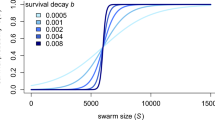Abstract
Colonies of social insects are sometimes viewed as superorganisms. The birth, reproduction, and death of colonies can be studied with demographic measures analogous to those normally applied to individuals, but two additional questions arise. First, how do adaptive colony demographies arise from individual behaviors? Second, since these superorganisms are made up of genetically distinct individuals, do conflicts within the colony sometimes modify and upset optima for colonies? The interplay between individual and superindividual or colony interests appears to be particularly complex in neotropical, swarm-founding, epiponine wasps such as Parachartergus colobopterus. In a long-term study of this species, we censused 286 nests to study colony-level reproduction and survivorship and evaluated individual-level factors by assessing genetic relatedness and queen production. Colony survivorship followed a negative exponential curve very closely, indicating type II survivorship. This pattern is defined by constant mortality across ages and is more characteristic of birds and other vertebrates than of insects. Individual colonies are long-lived, lasting an average of 347 days, with a maximum of over 4.5 years. The low and constant levels of colony mortality arise in part from colony initiation by swarming, nesting on protected substrates, and an unusual expandable nest structure. The ability to requeen rapidly was also important; relatedness data suggest that colonies requeen on average once every 9–12 months. We studied whether colony optima with respect to the timing of reproduction could be upset by individual worker interests. In this species, colonies are normally polygynous but new queens are produced only after a colony reaches the monogynous state, a result which is in accord with the genetic interests of workers. Therefore colony worker interests might drive colonies to reproduce whenever queen number happens to cycled down to one rather than at the season that is otherwise optimal. However, we found reproduction to be heavily concentrated in the rainy season. The number of new colonies peaked in this season as did the percentages of males and queens. Relatedness among workers reached a seasonal low of 0.21–0.27, reflecting the higher numbers of laying queens. This seasonality was achieved in part by a modest degree of synchrony in the queen reduction cycle. Worker relatedness reached peaks of around 0.4 in the dry season, reflecting a decrease to a harmonic mean queen number of about 2.5. Thus, a significant number of colonies must be approaching monogyny entering the rainy season. Coupled with polygynous colonies rearing only males (split sex ratios), this makes it possible for a colony cycle driven by selfish worker interests to be consistent with concentrating colony reproduction during a favorable season.
Similar content being viewed by others
Author information
Authors and Affiliations
Additional information
Received: 9 March 1996 / Accepted after revision: 6 October 1996
Rights and permissions
About this article
Cite this article
Strassmann, J., Solís, C., Hughes, C. et al. Colony life history and demography of a swarm-founding social wasp. Behav Ecol Sociobiol 40, 71–77 (1997). https://doi.org/10.1007/s002650050317
Issue Date:
DOI: https://doi.org/10.1007/s002650050317




